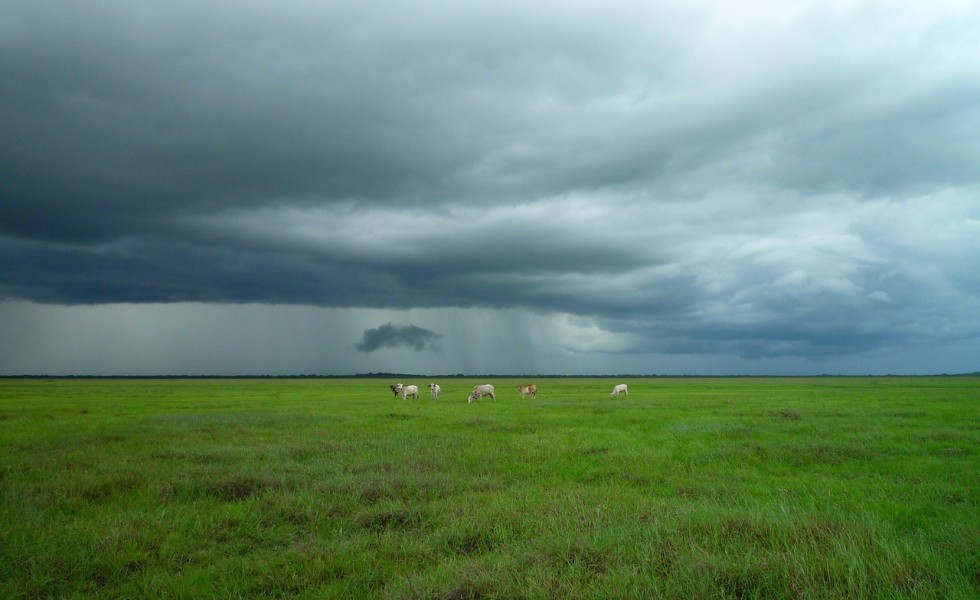Storm Brewing
Posted on July 15, 2015

As daylight faded, the growing, mid-August thunderstorm chased us eastward across the Kansas plains. In the rearview mirror, it looked like something out of the Wizard of Oz, a rolling mass of perfect fury.
Finally, just as we parked under the covered driveway of chain hotel in Russell about 9 pm, the storm caught us in a thunderous wave of hail and lightening. Its power was both horrifying and magnificent, a boiling cauldron of nature’s brawn and beauty. We watched in deafening silence, prisoners of its power.
Most everyone connected to U.S. agriculture—from ag bankers to corn growers to Land Grant economists to cotton producers to farm implement salespeople to crop insurance adjusters—know that “storm brewing” feeling. Many, in fact, nervously acknowledged its presence early last winter as storm clouds began to stack up shortly after grain prices began to sink.
That stormy darkness continues to build. In February, the U.S. Department of Agriculture issued its first 2015 “farm sector indicators” report. It was bleak. Net farm income in 2015, forecasted USDA, would plunge to $73.6 billion, a whopping 43 percent, or $55 billion, under 2013’s net and 32 percent, or $34.4 billion, under 2014’s net.
The one hopeful line in the February forecast (an update will be issued on Aug. 25) was U.S. agriculture’s overall financial bottom line, total “farm equity.” Surprisingly, USDA pegged farm equity nationwide at $2.7 trillion, a bump higher than the year before. The increase continues a five-year (2011-2015) climb of nearly $500 billion, or 23 percent, in overall farm equity.
While no one argued with that lovely equity number four months ago, few would take it to the bank today. Indeed, every ag bank and ag banker knows 2015 net farm income will fall far below the fat 2011-2014 average of $113 billion and they also suspect that land values, the other key component in farm equity, aren’t as strong as last month, let alone last February.
New data is beginning to surface to prove that suspicion correct. In May, the Chicago Federal Reserve’s AgLetter reported land values in its four-state district gained 1 percent in 2015’s first quarter largely because of hefty gains in Michigan and Wisconsin (5 and 8 percent, respectively). The bigger, more corn and soybean dependent states of Illinois, Indiana, and Iowa, however, saw land values drop 1, 1, and 6 percent, respectively.
Likewise, the Fed’s Tenth District, based in Kansas City, showed district-wide drops in all land values in 2015’s first quarter. “In fact,” noted the Fed in its May 14 Ag Credit Survey update, “irrigated cropland values declined… for the first time in more than five years.” A big reason behind the drop, it explained, is “reduced cash flows… for many crop producers.”
Those farmers won’t be alone. Nationwide, USDA forecasts total U.S. corn sales this year at $46.6 billion, or almost $30 billion under 2012 and $7 billion under 2014. The soybean outlook is lower, too: $38.4 billion in gross sales in 2015, $9 billion under 2013 and $2.2 billion under last year.
All these lighter numbers are adding up, Marcia Taylor reported May 29 on DTN. “(I)f USDA forecasts hold, inflation-adjusted farm incomes are expected to bust a 25-year-old record over the next few years.”
Quoting Jeff Swanhorst, the chief credit officer of AgriBank, a Farm Credit bank in St. Paul, Taylor noted that USDA projections for “net farm incomes through 2024 will be ‘lower than the 1990s…” when real (deflated) net farm income averaged $65 billion per year, or about $50 billion less than the glory years of 2010 to 2015.
Can U.S. farmers take that kind of whopping hit to their bottom line and still be standing five years from now? A decade from now?
We’re about to see because the forecast calls for continued weak grain markets, weakening land values, and even more storm clouds.
© 2015 ag comm
Share This